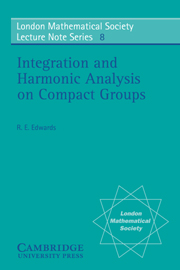Part 2 - Harmonic analysis on compact groups
Published online by Cambridge University Press: 26 March 2010
Summary
Introduction to Part 2
Harmonic analysis might be said to comprise the study of functions and function spaces defined over a topological group G, special reference being paid to the functional operators of translation arising from the group structure of G; see the discussion in Edwards [3], Chapter 2. This description is correct as far as it goes, but it is unlikely to convey much except to those who are already acquainted with the subject (and who therefore have no great need of a description anyway). The only effective way to discover what harmonic analysis is about, is to dip into it, taking stock of just enough (but not too much) detail. Our treatment attempts to present in such a style something from which the taster may choose.
As seems entirely natural, the display offered refers to one of the technically simpler cases: that in which the underlying group G is compact and Hausdorff. (The case in which G is also Abelian is even simpler, and some readers may wish to concentrate on this situation, which still offers many challenging problems.)
Even with the restrictions mentioned in 2. 0.1, there remain a number of approaches to abstract harmonic analysis. Their relative merits depend in part on how much is assumed about the underlying group G (always assumed locally compact and Hausdorff), though there are no sharp dividing lines. For compact groups, the various approaches are much on a par with each other and the choice is largely a matter of taste. We mention a few of the possible approaches.
- Type
- Chapter
- Information
- Integration and Harmonic Analysis on Compact Groups , pp. 42 - 162Publisher: Cambridge University PressPrint publication year: 1972

